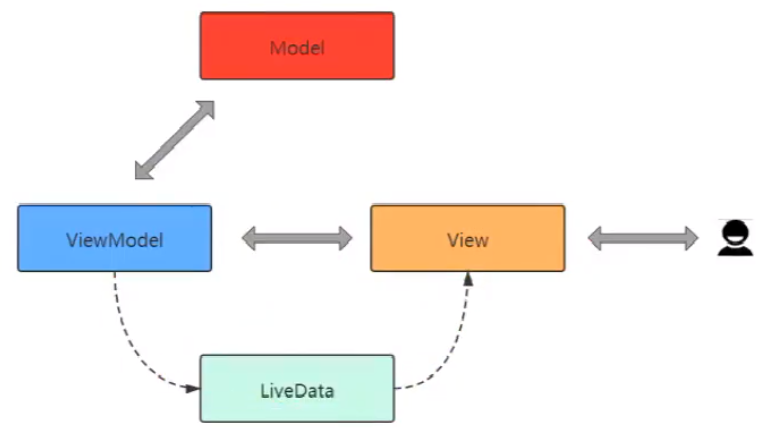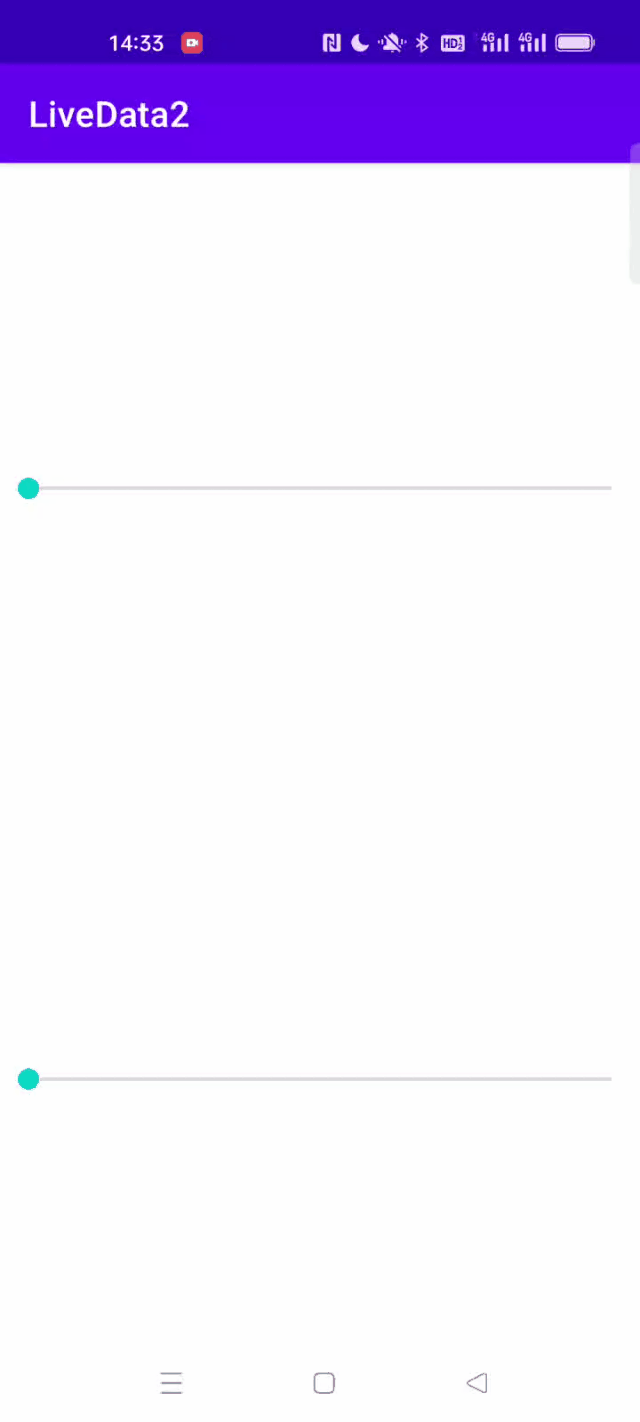您好,登錄后才能下訂單哦!
您好,登錄后才能下訂單哦!
這篇文章主要介紹了Android Jetpack組件中LiveData的優劣是什么的相關知識,內容詳細易懂,操作簡單快捷,具有一定借鑒價值,相信大家閱讀完這篇Android Jetpack組件中LiveData的優劣是什么文章都會有所收獲,下面我們一起來看看吧。
在 ViewModel 中的數據發生變化時,LiveData通知頁面。LiveData 是要和 ViewModel 一起使用的。

 確保界面符合數據狀態
確保界面符合數據狀態
 不會發生內存泄漏
不會發生內存泄漏
 不會因 Activity 停止而導致崩潰
不會因 Activity 停止而導致崩潰
 不再需要手動處理生命周期
不再需要手動處理生命周期
 數據始終保持最新狀態
數據始終保持最新狀態
 適當的配置更改
適當的配置更改
 共享資源
共享資源

使用 ViewModel + LiveData, 實現 Fragment 的通信。上面演示界面的兩個seekBar,分別位于兩個 Fragment 中(FirstFragment/SecondFragment, 都在 MainActivity 中),我們要實現拖動其中任何一個seekBar,另外一個seekBar 的值也會隨之改變。即要實現兩個 Fragment 之間的通信。
activity_main.xml
<?xml version="1.0" encoding="utf-8"?> <androidx.constraintlayout.widget.ConstraintLayout xmlns:android="http://schemas.android.com/apk/res/android" xmlns:app="http://schemas.android.com/apk/res-auto" xmlns:tools="http://schemas.android.com/tools" android:layout_width="match_parent" android:layout_height="match_parent" tools:context=".MainActivity"> <fragment android:id="@+id/first_fragment" android:name="com.example.livedata2.FirstFragment" android:layout_width="0dp" android:layout_height="0dp" app:layout_constraintBottom_toTopOf="@+id/guideline" app:layout_constraintEnd_toEndOf="parent" app:layout_constraintStart_toStartOf="parent" app:layout_constraintTop_toTopOf="parent" /> <androidx.constraintlayout.widget.Guideline android:id="@+id/guideline" android:layout_width="wrap_content" android:layout_height="wrap_content" android:orientation="horizontal" app:layout_constraintGuide_begin="366dp" /> <fragment android:id="@+id/second_fragment" android:name="com.example.livedata2.SecondFragment" android:layout_width="0dp" android:layout_height="0dp" app:layout_constraintTop_toBottomOf="@+id/guideline" app:layout_constraintEnd_toEndOf="parent" app:layout_constraintStart_toStartOf="parent" app:layout_constraintBottom_toBottomOf="parent" /> </androidx.constraintlayout.widget.ConstraintLayout>
fragment_first.xml / fragment_second.xml(它們兩個布局一樣)
<?xml version="1.0" encoding="utf-8"?> <androidx.constraintlayout.widget.ConstraintLayout xmlns:android="http://schemas.android.com/apk/res/android" xmlns:app="http://schemas.android.com/apk/res-auto" xmlns:tools="http://schemas.android.com/tools" android:layout_width="match_parent" android:layout_height="match_parent" tools:context=".SecondFragment"> <SeekBar android:id="@+id/seekBar" android:layout_width="0dp" android:max="100" android:layout_height="wrap_content" app:layout_constraintBottom_toBottomOf="parent" app:layout_constraintEnd_toEndOf="parent" app:layout_constraintStart_toStartOf="parent" app:layout_constraintTop_toTopOf="parent" /> </androidx.constraintlayout.widget.ConstraintLayout>
MyViewModel.java
LiveData 類型數據是寫在 ViewModel 中的。MutableLiveData 繼承自 LiveData,是它的子類,LiveData 是一個抽象類。
package com.example.livedata2;
import androidx.lifecycle.MutableLiveData;
import androidx.lifecycle.ViewModel;
public class MyViewModel extends ViewModel {
private MutableLiveData<Integer> progress;
public MutableLiveData<Integer> getProgress() {
if (progress == null) {
progress = new MutableLiveData<>();
progress.setValue(0);
}
return progress;
}
}上面代碼定義了一個 LivaData 類型的 progress,通過監聽它的值的改變,來動態改變 view 界面顯示的內容。
FirstFragment.java
package com.example.livedata2;
import android.os.Bundle;
import androidx.fragment.app.Fragment;
import androidx.lifecycle.Observer;
import androidx.lifecycle.ViewModelProvider;
import android.view.LayoutInflater;
import android.view.View;
import android.view.ViewGroup;
import android.widget.SeekBar;
import java.util.Objects;
public class FirstFragment extends Fragment {
private SeekBar seekBar;
private MyViewModel viewModel;
@Override
public View onCreateView(LayoutInflater inflater, ViewGroup container,
Bundle savedInstanceState) {
// Inflate the layout for this fragment
View root = inflater.inflate(R.layout.fragment_f_irst, container, false);
seekBar = root.findViewById(R.id.seekBar);
// TODO 獲取到 MyViewModel 對象
viewModel = new ViewModelProvider(requireActivity(),
new ViewModelProvider.AndroidViewModelFactory(requireActivity().getApplication())).get(MyViewModel.class);
// TODO 監聽 (LiveData)progress 數據的改變
viewModel.getProgress().observe(requireActivity(), new Observer<Integer>() {
@Override
public void onChanged(Integer i) {
seekBar.setProgress(i);
}
});
// TODO 當拖動 seekBar 時,改變 (LiveData)progress 的值
seekBar.setOnSeekBarChangeListener(new SeekBar.OnSeekBarChangeListener() {
@Override
public void onProgressChanged(SeekBar seekBar, int progress, boolean fromUser) {
viewModel.getProgress().setValue(progress);
}
@Override
public void onStartTrackingTouch(SeekBar seekBar) {
}
@Override
public void onStopTrackingTouch(SeekBar seekBar) {
}
});
return root;
}
}當用戶手動拖動 seekBar 時,SeekBar.setOnSeekBarChangeListener.onProgressChanged() 方法里將拖動的值賦給(LiveData)progress,然后 viewModel.getProgress().observe() 監聽(LiveData)progress 值的改變,然后再顯示在 view 上。
FirstFragment.java
SecondFragment 里的內容和 FirstFragment 里的內容一樣,只是加載的布局不一樣,如下:
View root = inflater.inflate(R.layout.fragment_second, container, false);
因為FirstFragment 與SecondFragment 共用了MyViewModel里的(LiveData)progress,然后顯示在 view 上。所以當我拖動任意一個 seekBar 而改變了(LiveData)progress 的值,另外一個 Fragment 的 seekBar 也會隨著改變。從而實現了兩個 Fragment 之間的通信。
MainActivity.java
package com.example.livedata2;
import androidx.appcompat.app.AppCompatActivity;
import android.os.Bundle;
public class MainActivity extends AppCompatActivity {
@Override
protected void onCreate(Bundle savedInstanceState) {
super.onCreate(savedInstanceState);
setContentView(R.layout.activity_main);
}
}關于“Android Jetpack組件中LiveData的優劣是什么”這篇文章的內容就介紹到這里,感謝各位的閱讀!相信大家對“Android Jetpack組件中LiveData的優劣是什么”知識都有一定的了解,大家如果還想學習更多知識,歡迎關注億速云行業資訊頻道。
免責聲明:本站發布的內容(圖片、視頻和文字)以原創、轉載和分享為主,文章觀點不代表本網站立場,如果涉及侵權請聯系站長郵箱:is@yisu.com進行舉報,并提供相關證據,一經查實,將立刻刪除涉嫌侵權內容。